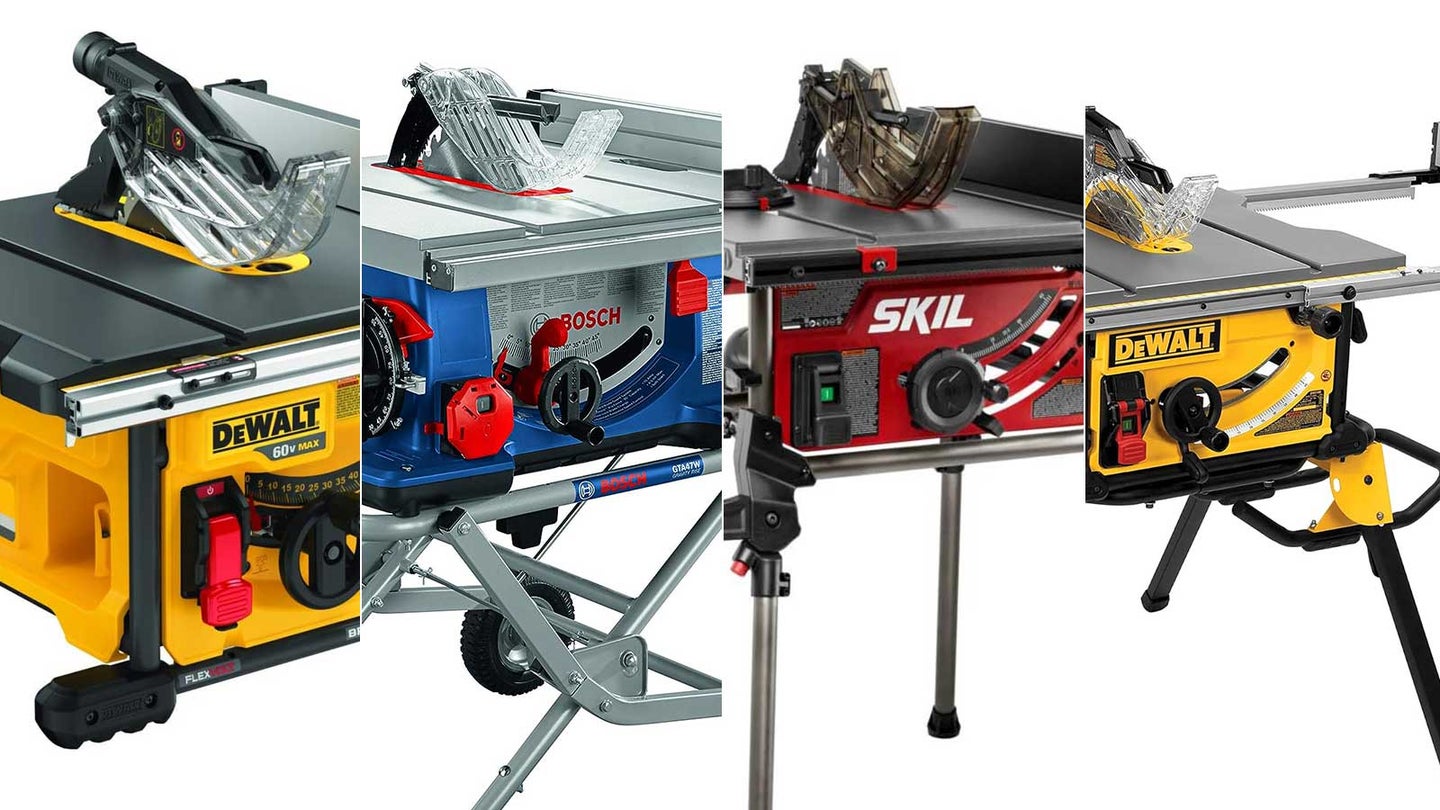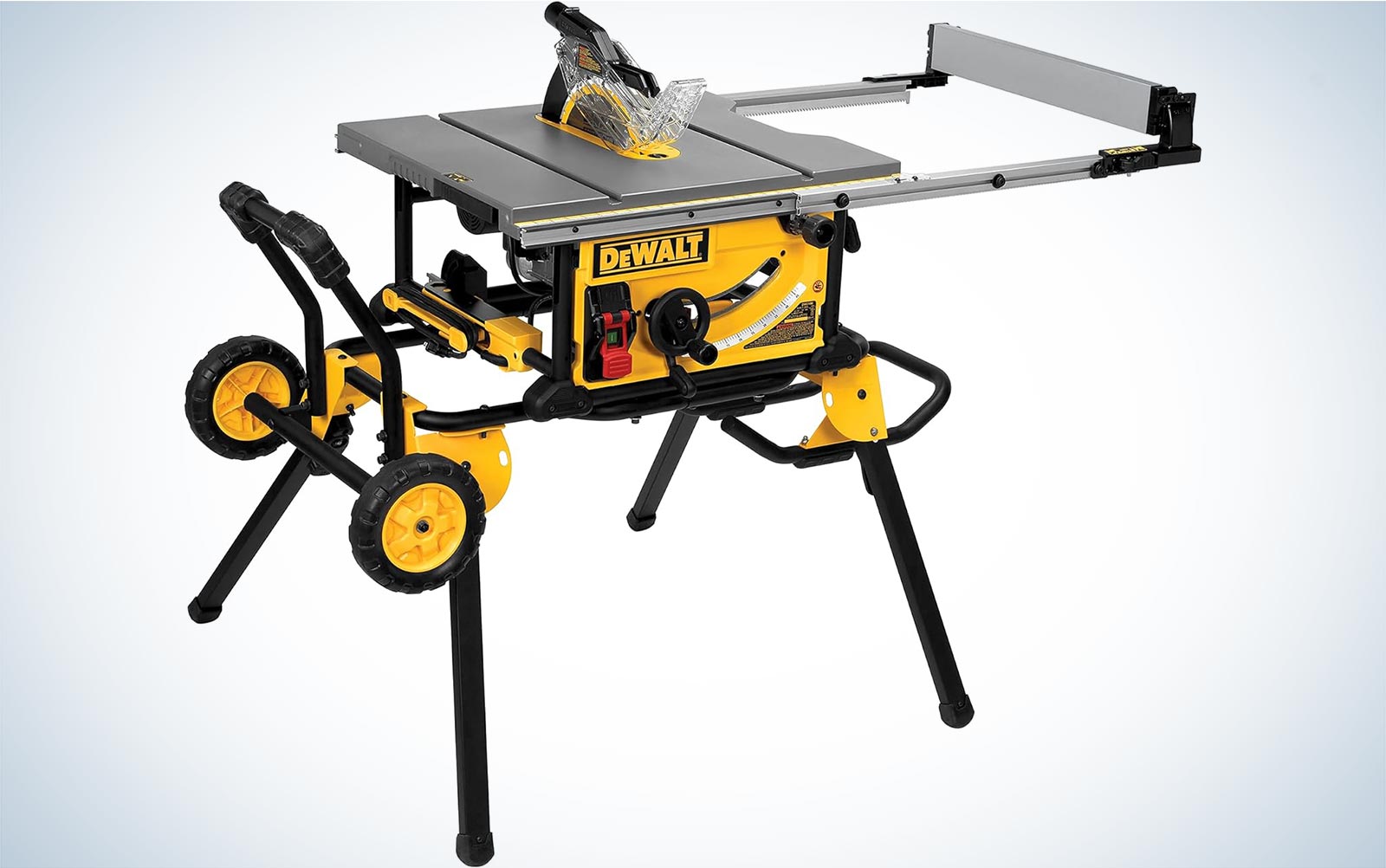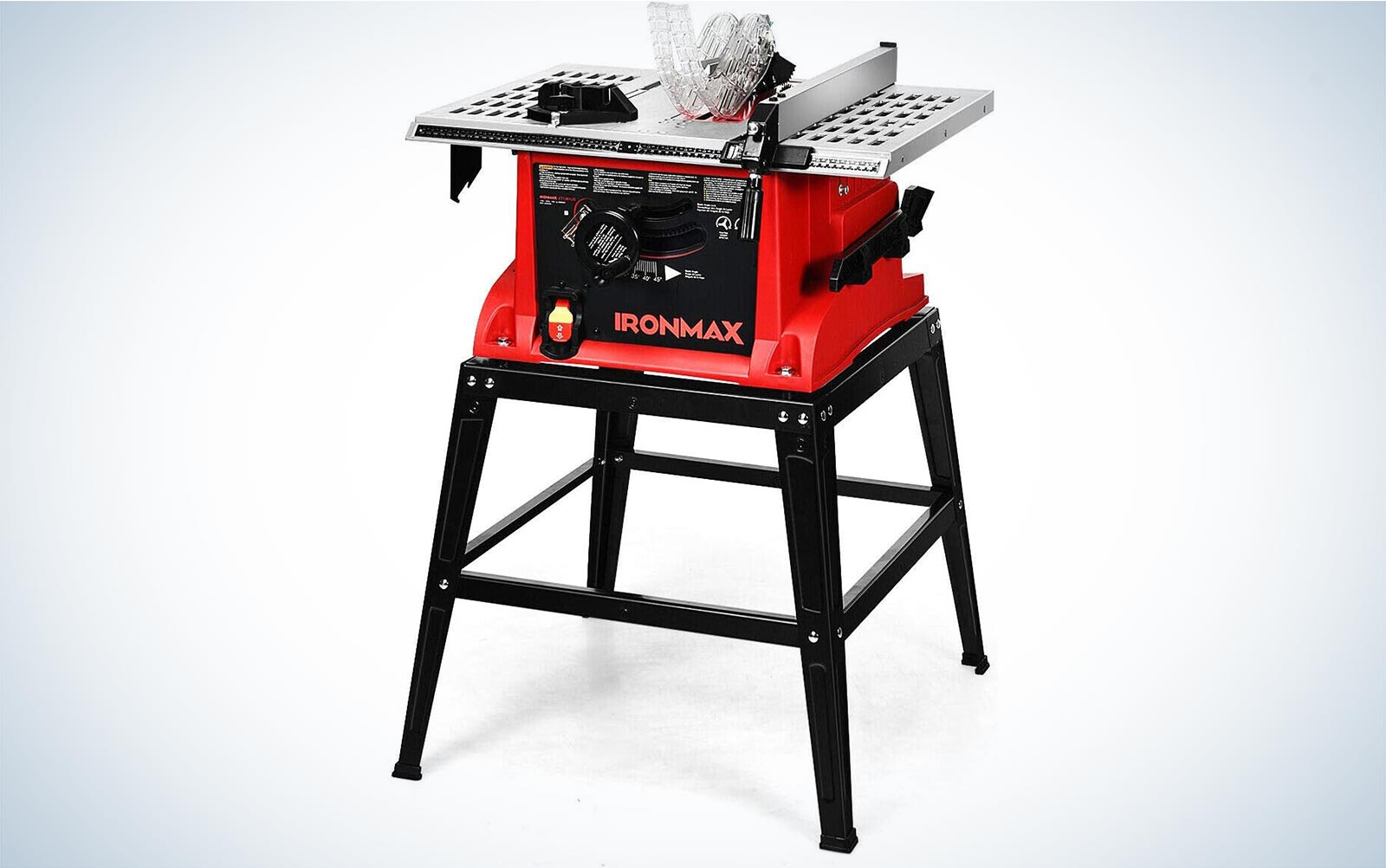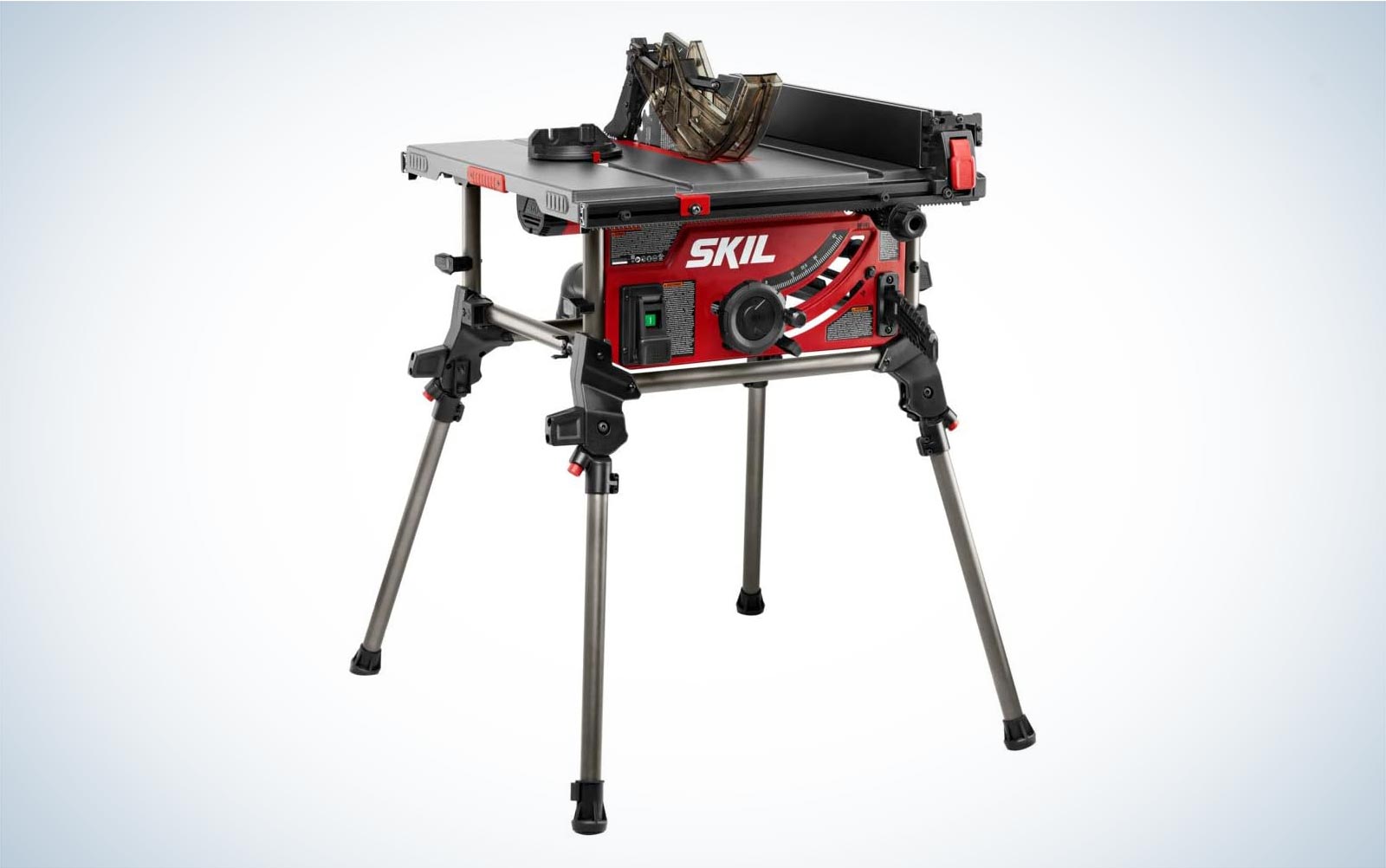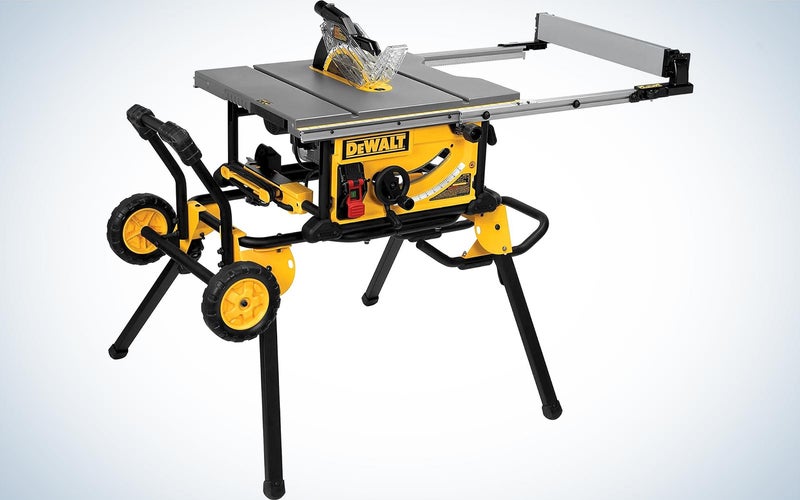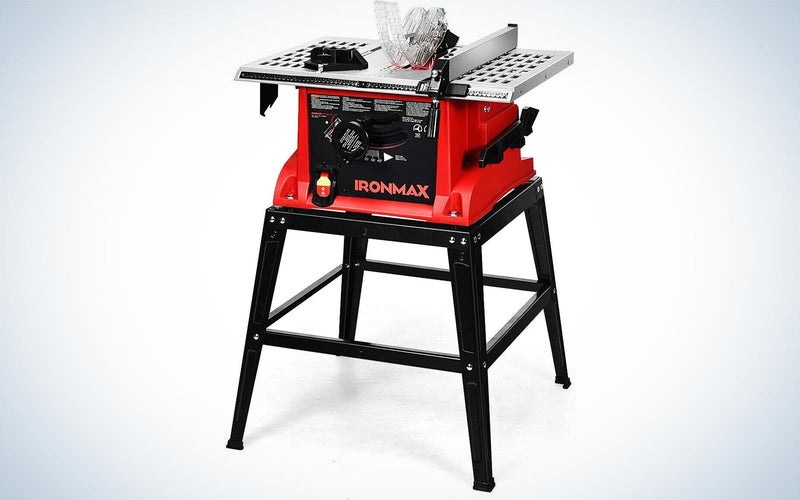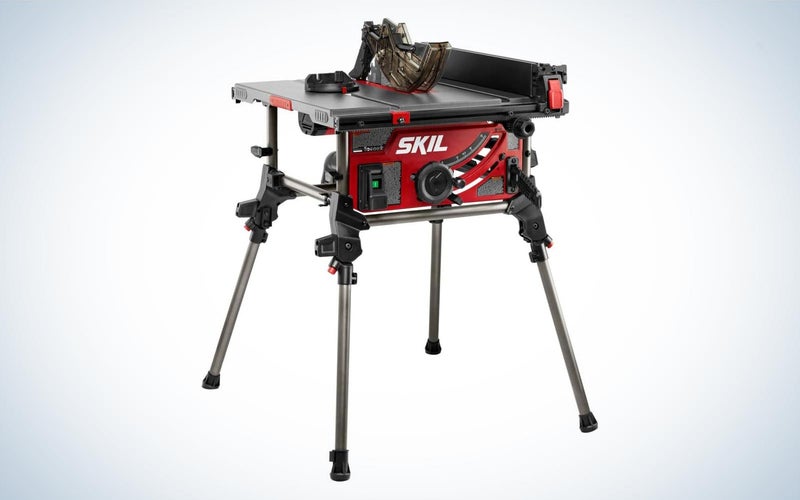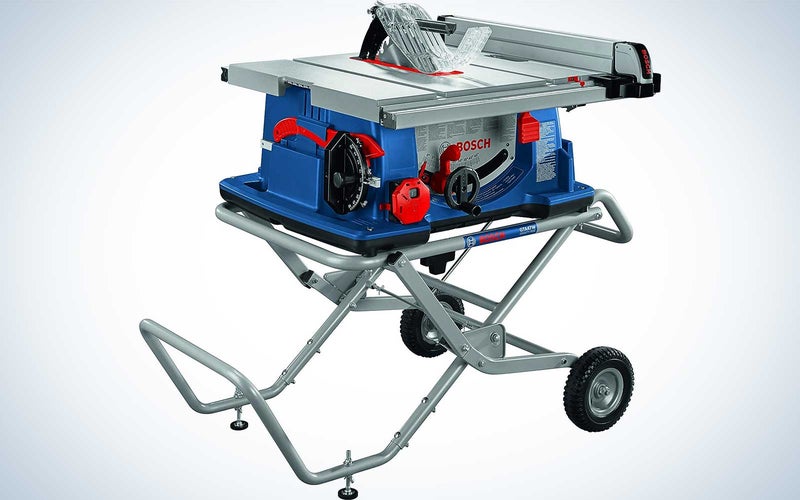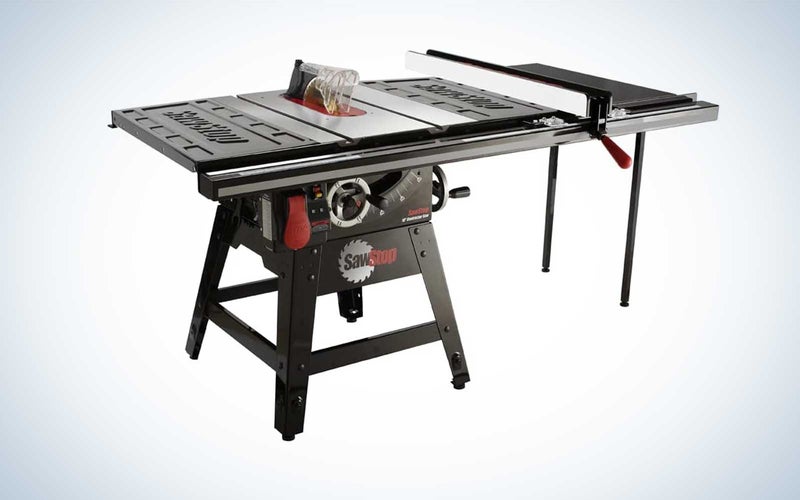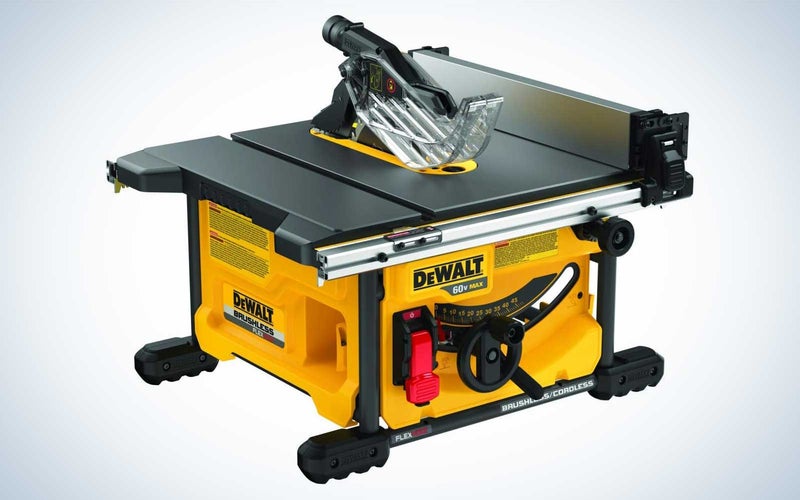We may earn revenue from the products available on this page and participate in affiliate programs. Learn more ›
Table saws come in a variety of sizes, from bench-top models popular with DIYers through jobsite saws to cabinet saws used in furniture making. While they are perhaps most used for making long, accurate ripping cuts through boards and sheet material, they can also crosscut at various angles and, with specialist blades, create rabbets (steps) and dadoes (grooves) for joints, door panels, or drawer bottoms. They range in price from a couple hundred dollars to several thousand, depending on the specs. In this article, we’re checking out the key features of these versatile tools and looking at the best table saws for both trade users, and DIY enthusiasts.
- Best overall: DeWalt DWE7491RS 10-Inch Table Saw
- Best budget: GoPlus Ironmax 10-Inch Table Saw
- Best folding: Skil TS6307-00 10-Inch Portable Table Saw
- Best for jobsites: Bosch 4100XC-10 10-Inch Worksite Table Saw
- Best for shops: SawStop CNS175-TGP236 10-Inch Contractor Saw
- Best cordless: DeWalt DCS7485B Flexvolt 8-1/4-Inch Table Saw
How we chose the best table saws
I owned my own woodshop for 10 years and used table saws daily. I am also a qualified engineer, so I know what makes a good saw tick. To supplement my own hands-on experience, we researched a host of current models from both leading and less well-known manufacturers. This ensured we understood what was available and were up-to-date on technological advances.
The variety of table saws available is extensive, so we wanted to represent as many different types as possible in our collated selection. Our picks range from portable benchtop table saws to models called contractor saws designed for pro woodshops.
Cutting capacities are, of course, a key issue, but so is accuracy and stability. Table saw buyers will also be keen to know that their tool will be reliable and durable, so we factored this into our thoughts. Finally, there’s value for money, which doesn’t necessarily mean finding the cheapest table saw but rather those that meet performance expectations while keeping prices at an affordable level.
The best table saws: Reviews & Recommendations
The following models all meet the performance and cost criteria we set, but each of them has different capabilities and their own pros and cons. We have assigned categories to make finding the best table saw for a particular range of tasks easier, but all of our picks are tools we’d be proud to keep in our storage shed.
Best overall: DeWalt DWE7491RS 10-Inch Table Saw
DeWalt
Why it made the cut: This high-quality tool offers performance that makes it suitable for busy professionals, enthusiastic DIYers, or home furniture makers.
Specs
- Blade Size: 10 inches
- Maximum Depth of Cut: 3-1/8 inches
- Maximum Rip: 32-1/2 inches
- Table Size: 21-7/8 x 26-3/8 inches
Pros
- Pro-grade build quality and reliability
- Good cutting capacities and precise fence
- Stand offers stability and improves mobility
Cons
- Supplied blade could be better
- Premium price tag
Given the variety available, it’s almost impossible to pick a single best table saw that will meet everyone’s needs. The DeWalt DWE7491RS is the one that, in our opinion, comes closest. It has the performance and durability demanded by tradespeople, and capacities that could make it the only table saw most keen DIYers ever need.
Maximum depth of cut is 3-1/8 inches, meaning it will easily handle 2x dimensioned lumber used for framing and construction. A ripping capacity (maximum width of cut) of 32-1/2 inches makes it great for plywood and other sheet materials. The table offers good support, and the extending fence has a rack and pinion drive that makes it easy to use, and delivers repeatable accuracy. There’s a nice chunky wheel for blade angle adjustment and a big stop button front and center where it’s easy to reach in an emergency. There’s a 2-1/2” dust port that can be hooked up to a shop vac or other extraction. The included blade is 24-tooth TCT (tungsten carbide tipped). It’s OK, but those looking for a better finish to their cuts will want to upgrade.
The DeWalt table saw comes with a rolling stand that offers good stability and folds down quickly for transportation. It is held in place with four bolts, so it is easy to remove for bench-top use if preferred.
Best budget: GoPlus Ironmax 10-Inch Table Saw
GoPlus
Why it made the cut: For those on a restricted budget, this table saw offers similar features and capacities to those from leading brands.
Specs
- Blade Size: 10 inches
- Maximum Depth of Cut: 3 inches
- Maximum Rip: 26 inches
- Table Size: 19 x 26 inches
Pros
- Offers good value for money
- Competitive cutting capacities and feature set
- Includes 36-tooth TCT blade
Cons
- Quality control is inconsistent
- May arrive requiring considerable adjustment
We generally avoid power tools from lesser-known brands for fear of poor build quality or reliability. The GoPlus table saw is an exception. It might not be the tool for precision woodworking, but it has similar features and capacities to many better-known rivals at a fraction of the price.
With a maximum depth of cut of 3 inches and ripping of up to 26 inches, it will handle most common store-bought construction and DIY materials. The aluminum table has been coated to provide an easier sliding surface. The fence runs on plain rails rather than rack and pinion, but it has an easy adjustment system and a magnifier lens over the scale to improve readability. The included stand raises the saw to a comfortable working height. Assembly involves 24 bolts, so it takes a few minutes to put together, but it provides good support once assembled. A surprisingly good 36-tooth TCT blade is included.
So far, so good. However, while most buyers we surveyed appear happy, inconsistent quality control means some saws arrive needing a lot of adjustment before they can be used. Whether the GoPlus is the right table saw for you will depend on what is expected of it. It is suitable for many construction and DIY jobs around the home and yard, but we wouldn’t recommend it for those expecting high accuracy.
Best folding: Skil TS6307-00 10-Inch Portable Table Saw
Skil
Why it made the cut: Skil is one of the world’s leading saw brands, and this model’s integrated folding stand combines sturdy support with easy portability.
Specs
- Blade Size: 10 inches
- Maximum Depth of Cut: 3-1/2 inches
- Maximum Rip: 25-1/2 inches
- Table Size: 24 x 25 inches
Pros
- Stand folds easily for portability
- Tool-free blade alignment
- Accurate rack and pinion fence
Cons
- Some plastic components are fragile
- Customer support has been criticized
Several of the top table saws we looked at offer good stands, but none match the simple efficiency and affordability of the folding stand on this Skil model. In fact, this table saw is an attractive proposition all around. While it costs more than some of the budget table saws available, it is well below the price of premium models and, in many ways, offers comparable performance.
When deployed, the Skil table saw stand provides the stability necessary for working with large sheet materials. To use the saw as a benchtop model, there’s no need to undo lots of nuts and bolts; the legs tuck under with a simple button push.
A 3-1/2 inch maximum depth of cut is very competitive, though the 25-1/2 inch rip is less than some. The fence has the rack and pinion adjustment we prefer for accuracy, and the tool-free micro adjustment for blade alignment is a nice feature. However, the supplied blade is only 24-tooth TCT. It’s not bad, but those working with hardwoods will probably want to buy something more robust.
Best for jobsites: Bosch 4100XC-10 10-Inch Worksite Table Saw
Bosch
Why it made the cut: A high-performance jobsite saw with a wheeled gravity lift stand that rises and falls in seconds.
Specs
- Blade Size: 10 inches
- Maximum Depth of Cut: 3-1/8 inches
- Maximum Rip: 30 inches inches
- Table Size: 22-1/2 x 30 inches
Pros
- Powerful 4HP motor for effortless cutting
- Constant response circuitry maintains performance
- Excellent rolling stand for jobsite mobility
Cons
- Expensive, and heavy with stand attached
- Poor assembly instructions
Jobsite table saws need to be reliable and durable in working environments that are often harsh. The Bosch 4100XC-10 is a proven solution that is powerful, accurate, and comes with a gravity rise stand that provides virtually effortless single-handed operation.
Cutting capacities are among the best on the market with 3-18 inch maximum depth and 30-inch ripping. The table surface is the largest we looked at on a portable saw, offering a stable platform for large-scale cutting. The motor is an impressive 4-horsepower unit, and the Bosch worksite saw features constant load circuitry that measures blade feedback and matches power output to the demands of the material being cut so the blade won’t stall. The SquareLock fence isn’t rack and pinion, but it is very sturdy. It fits neatly into a slot on the side for transportation.
While the stand is excellent in operation, there are a couple of negatives. It doesn’t come pre-assembled, and the instructions for putting it together are poor. Once finished mounting, the sawing is best done by two people. The other consideration is the all-up weight, which is 94 pounds, so while it’s easy to roll to the truck at the end of the day, lifting it requires a little more effort.
Best for shops: SawStop CNS175-TGP236 10-Inch Contractor Saw
SawStop
Why it made the cut: A high-performance, high-capacity, and high-precision contractor-grade saw for discerning professionals or enthusiastic home furniture makers
Specs
- Blade Size: 10 inches
- Maximum Depth of Cut: 3-1/8 inches
- Maximum Rip: 36 inches
- Table Size: 27 x 44 inches
Pros
- Patented SawStop safety system
- T-Glide fence does no deflect
- Includes excellent 40-tooth TCT blade
Cons
- A considerable investment
- Replacement brake cartridges are expensive
The SawStop contractor saw is a superbly engineered tool built for high-precision woodworking. The table is cast iron rather than aluminum for added strength and rigidity and has a flatness within ten-thousandths of an inch (measured diagonally). Extension tables are steel.
Given the 10-inch blade, the maximum depth of cut is a fairly standard 3-1/8 inches. However, ripping is 36 inches, and extensions can be added to take it out to 52 inches. The T-Glide fence is heavy-gauge steel to prevent deflection under load. Versatility is such that a router table can also be added, saving valuable workshop space. A sliding crosscut table, popular with professionals, is also available.
The headline feature is the patented SawStop safety system that can detect human skin and will stop the blade and drop it under the saw table in under five milliseconds. This remarkable device means that instead of losing fingers, all the woodworker will have is a scratch. The only downside is that the special sensor cartridge has to be replaced after an event, and they’re not cheap.
The SawStop contractor saw is a considerable investment, but compared with rivals of a similar standard, it’s very competitive.
Best cordless: DeWalt DCS7485B Flexvolt 8-1/4-Inch Table Saw
DeWalt
Why it made the cut: Has the excellent build quality and reliability associated with the brand and delivers 60V power where rivals only offer 18V.
Specs
- Blade Size: 8-1/4 inches
- Maximum Depth of Cut: 2-1/2 inches
- Maximum Rip: 24 inches
- Table Size: 14-1/5 x 26-3/4 inches
Pros
- Go-anywhere cordless cutting
- Class-leading 60V power
- Protective metal roll cage
Cons
- Modest capacities
- Battery and charger not included
The ability to take a table saw anywhere, regardless of whether there’s electricity available, has obvious benefits whether you’re a contractor or just want to work beyond the range of extension cords (which, for safety reasons, should never be more than 100 feet). The DeWalt DCS7485B Flexvolt gives that ability, and where most rivals offer 18V batteries, this model uses DeWalt’s high-performance 60V unit, meaning more power for longer.
Cordless does come with a compromise. Table saws are quite power-hungry tools, so in order to provide decent cutting performance, the blade is reduced to 8-1/4 inches. This, of course, means lower capacities. However, with a maximum depth of 2-1/2 inches and a maximum rip of 24 inches, this is still a very useful saw for DIY and light-duty trade use.
Portability is another major benefit of cordless table saws. The DeWalt weighs 45 pounds and has carry handles that double as feet, plus a steel roll cage to protect internal components from knocks. There’s often a premium to pay for cordless tools, and that’s true here. By the time battery and charger are added, this saw is a similar price to high-quality 10-inch corded table saws.
What to consider before buying a table saw
All table saws function in basically the same way, but size and configuration can vary dramatically. In this section, we look at what impact those aspects have on finding the best table saw for particular needs.
Types of table saw
Table saws can be divided into five main types:
- Benchtop table saws are self-explanatory. These are the smallest and lightest table saws and are usually the choice for DIY users who have limited space or might only use a table saw occasionally.
- Jobsite table saws are probably the most popular type. They are usually supplied with a stand that gives the stability required for working with large sheet materials. Wheels help with mobility. They are also a good choice for more enthusiastic DIY users.
- Contractor table saws are the smallest of what might be described as ‘fixed’ saws. They are designed for permanent shop use and have a larger ripping capacity than benchtop or jobsite models.
- Hybrid & cabinet table saws are larger versions of the contractor saw and are normally only found in professional woodworking shops. Where contractor table saws sit on sturdy legs, hybrid and cabinet saws usually have fully enclosed cabinets that provide even greater stability.
Blade size and capacities
High-end table saws for commercial use can have 12-inch diameter blades, but 10-inch is by far the most common. This means maximum depth of cut is broadly similar, though still varies between 3 and 3-1/2 inches. Cordless models are usually 8-1/4-inch with a depth of cut of around 2-1/2 inches.
The big difference is ripping capacity or maximum width. On benchtop table saws, this can be as little as 24 inches, whereas cabinet table saws can offer 60 inches or more. Greater ripping capacity and the larger table surface that goes with it are particularly important for those who frequently work with sheet material. Not only does it offer wider cuts, but also a more stable platform, so it’s easier to maintain accuracy.
Fence and miter gauge
The ripping fence (usually just called the fence) is another element that has a major impact on accuracy. It keeps the material in place as you perform long cuts. If it deflects when material is pushed against it, the cut won’t remain true. As a result, these devices are usually a substantial construction with secure clamping.
The rails are also important. Often, the fence just slides along these and then clamps in position. Some benchtop and jobsite saws offer rack and pinion rails, which make it easier to make fine adjustments.
A miter gauge is usually included for making angled crosscuts. On cheap table saws, these are often criticized, though better alternatives are widely available.
Other features
- A blade guard and riving knife (which prevents the material from pinching the blade and causing kickback) are important safety features. These should never be removed while the saw is in use.
- Weight may be a factor if the table saw is going to be moved around the workshop or transported regularly. Some are fitted with wheeled stands, but larger models can be awkward to lift in and out of a vehicle.
- Dust ports are usually fitted, but it’s worth checking size if a shop vac or other extraction will be used. Low-cost adaptors are available if existing equipment doesn’t match.
- Convenient onboard storage for blade wrenches, miter gauges, a push stick, and other accessories is often provided.
FAQs
Q: Is a table saw better than a miter saw?
Their main functions are different, so it’s not really a case of one being better than the other. A table saw can crosscut framing lumber, etc., but doesn’t have the depth of cut or versatility that a miter saw has for compound angles. On the other hand, a miter saw can’t cut sheet material like plywood or OSB. It’s important to understand how each saw works before making that decision.
Q: Is a table saw safe for beginners?
When operated according to the manufacturer’s instructions with guards and riving knife in place, a table saw is as safe as any other type of saw. Use protective eyewear or a face shield, and a dust mask are always recommended.
Q: How long will a table saw last?
It will depend on how much it is used, the working environment, and how well it is maintained, but 10 years is usually given as the expected life of a table saw.
Final thoughts on the best table saws
- Best overall: DeWalt DWE7491RS 10-Inch Table Saw
- Best budget: GoPlus Ironmax 10-Inch Table Saw
- Best folding: Skil TS6307-00 10-Inch Portable Table Saw
- Best for jobsites: Bosch 4100XC-10 10-Inch Worksite Table Saw
- Best for shops: SawStop CNS175-TGP236 10-Inch Contractor Saw
- Best cordless: DeWalt DCS7485B Flexvolt 8-1/4-Inch Table Saw
As we’ve seen from the selection above, there are high-quality table saws that will suit everyone from beginners on a budget to full-time tradespeople. The DeWalt DWE7491RS is a terrific all-rounder. It has the performance and capacities that professionals demand and, with proper care, might also be the only table saw many home woodworkers ever need. At the other end of the price scale, the GoPlus table saw is an ideal solution for those who want the benefits a table saw offers but might never go beyond occasional DIY or small furniture projects (and who might want to read our guides to orbital sanders and laser levels next).
If you’re looking for other cutting tools, check out our lists of the best miter saws and the best circular saws. The right tool makes the job much simpler.
Why trust us
Popular Science started writing about technology more than 150 years ago. There was no such thing as “gadget writing” when we published our first issue in 1872, but if there was, our mission to demystify the world of innovation for everyday readers means we would have been all over it. Here in the present, PopSci is fully committed to helping readers navigate the increasingly intimidating array of devices on the market right now.
Our writers and editors have combined decades of experience covering and reviewing consumer electronics. We each have our own obsessive specialties—from high-end audio to video games to cameras and beyond—but when we’re reviewing devices outside of our immediate wheelhouses, we do our best to seek out trustworthy voices and opinions to help guide people to the very best recommendations. We know we don’t know everything, but we’re excited to live through the analysis paralysis that internet shopping can spur so readers don’t have to.
